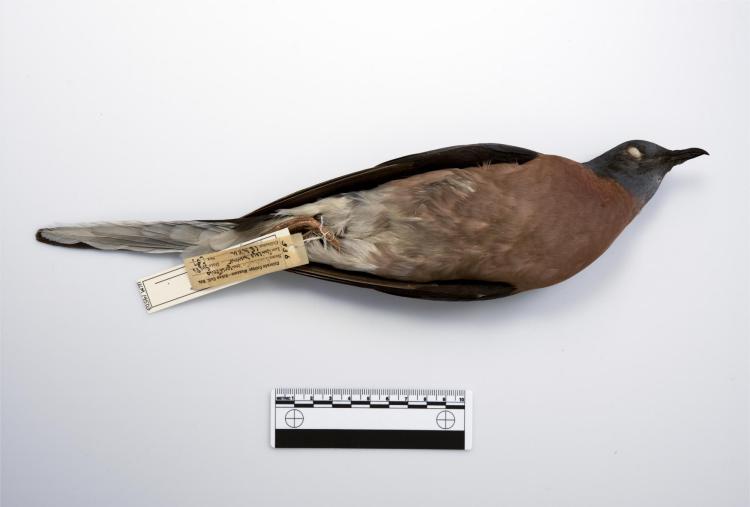The CU Museum is closed we will be opening early in the spring semester.
During this time, collection visits will be available by appointment and other special access requests will be considered on a case-by-case basis.
Please email cumuseum@colorado.edu for more information.
Passenger Pigeon
The passenger pigeon (Ectopistes migratorius) once migrated in flocks of 3 to 5 billion, numbers great enough to black out the sky, but by 1914, the last of its kind, named “Martha,” passed away at the Cincinnati Zoo. Martha had been the last passenger pigeon alive in captivity, while the last known wild passenger pigeon reportedly died out in Ohio in 1900. The day that Martha died, the long legacy of the once most populous bird species in the world ended, after just 50 years of rapid population decline.

Deforestation of the eastern U.S. for farming and lumber over the course of the 19th century diminished the mixed hardwood forests that huge flocks of passenger pigeons relied on for food, wintering grounds, and nesting habitat. In search of food, pigeons flocked to farmer’s fields, who killed them in retaliation for damaging crops. This led to the passenger pigeon becoming a staple American dish– while populations were still plentiful. As a colonial species, passenger pigeons relied on safety in numbers as a mechanism of defense, and as a result, commercial hunters routinely trapped hundreds of pigeons at a time. (Interesting note: the term ‘stool pigeon’ comes from the practice of tying a passenger pigeon’s foot to a stool so that it’s fluttering wings would attract the rest of the flock, betraying them to the waiting hunters.)
Implementation of railroads allowed for industrial-scale transport of hundreds of thousands of pigeons per year to markets across the country, which had devastating effects. By the time Americans realized the pigeons’ dramatically lower population numbers, the damage was irreversible. Nonetheless, in efforts to prevent similar extinctions, the tragic fate of the passenger pigeon inspired the United States government to pass the first wave of wildlife protection laws, including the Lacey Act, the Weeks-McLean Act, and the Migratory Bird Treaty Act, which granted protection to birds alongside their eggs, nests, and feathers.
At the University of Colorado Museum of Natural History, we are fortunate enough to house five rare passenger pigeon specimens of the 1,190 passenger pigeon specimens left on earth. This specimen (UCM: Bird:14503) was acquired by Charles E. Aiken in the spring of 1886 when he purchased the live bird at a marketplace in Chicago. Originally, the pigeon was wild caught in either Wisconsin or Michigan. Though the passenger pigeon is extinct today, specimens preserved in museum collections allow researchers the opportunity to continue studying the species using methods such as DNA analysis or anatomical observation.
The passenger pigeon serves both as a cautionary tale for environmental protection and to highlight the importance of museum collections in archiving life on earth.

